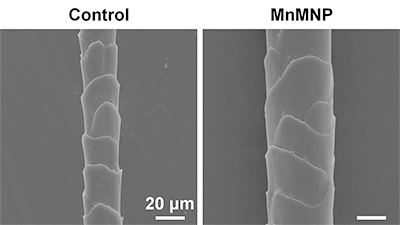FOR IMMEDIATE RELEASE
“Site-specific Phosphor-tau Aggregation-based Biomarker Discovery for AD Diagnosis and Differentiation”
ACS Chemical Neuroscience

A definitive diagnosis of Alzheimer’s disease (AD) was once only possible after someone had died, but recent biomarker studies have led to the development of imaging and spinal fluid tests for those still living. However, the tests can only monitor severe disease, differentiating advanced AD from related disorders. Reporting in ACS Chemical Neuroscience, researchers have now identified a biomarker that could help physicians diagnose AD earlier, as a patient transitions into mild cognitive impairment (MCI).
When hunting for AD biomarkers, some researchers have turned to the study of subtle changes in a protein called tau. These changes, or posttranslational modifications, can make the tau protein more likely to clump, which leads to neuron loss and impaired memory. Two such modifications involve the phosphorylation of tau at specific amino acids, resulting in versions called p-tau181 and p-tau217. These biomarkers have been shown to effectively differentiate AD tissues from those of people with other neurodegenerative diseases. Because it’s helpful to have many biomarkers in the physicians’ toolbox, Bin Xu, Jerry Wang, Ling Wu and colleagues sought additional p-tau biomarkers that could be effective AD diagnostics, or that could perhaps catch AD at its early stages.
Using post-mortem brain tissue from AD patients and non-AD subjects, the researchers identified several p-tau biomarkers selectively associated with tau aggregation. Like p-tau181 and p-tau217, several of these biomarkers differentiated AD tissues from healthy controls. One in particular — p-tau198 — also discriminated AD from two other neurodegenerative diseases in which tau is known to clump. Further experiments showed that p-tau198 was as effective as p-tau181 and p-tau217 in these assays. Importantly, both p-tau 198 and p-tau217 also could differentiate brain tissue of patients with MCI — an early sign of AD — from older subjects without the impairment. According to the researchers, no well-established biomarkers that can diagnose MCI currently exist. Thus, p-tau198 and p-tau217 could help clinicians intervene early, as new treatments become available, before significant neurological damage occurs. In addition, the researchers say this method could be used to find tau biomarkers with other modifications aside from phosphorylation.
The authors acknowledge funding from the Biomarkers Across Neurodegenerative Diseases Program of the Alzheimer’s Association, Alzheimer’s Research UK, The Michael J. Fox Foundation for Parkinson’s Research, the Weston Brain Institute; Duke Clinical & Translational Science Institute; the National Institutes of Health; the Commonwealth of Virginia’s Alzheimer’s and Related Diseases Research Award Fund; Diabetes Action Research and Education Foundation; and the Duke/UNC Alzheimer’s Disease Research Center.
The authors have filed a provisional patent on the work.
###
The American Chemical Society (ACS) is a nonprofit organization chartered by the U.S. Congress. ACS’ mission is to advance the broader chemistry enterprise and its practitioners for the benefit of Earth and all its people. The Society is a global leader in promoting excellence in science education and providing access to chemistry-related information and research through its multiple research solutions, peer-reviewed journals, scientific conferences, eBooks and weekly news periodical Chemical & Engineering News. ACS journals are among the most cited, most trusted and most read within the scientific literature; however, ACS itself does not conduct chemical research. As a leader in scientific information solutions, its CAS division partners with global innovators to accelerate breakthroughs by curating, connecting and analyzing the world’s scientific knowledge. ACS’ main offices are in Washington, D.C., and Columbus, Ohio.
To automatically receive press releases from the American Chemical Society, contact newsroom@acs.org.
Note: ACS does not conduct research, but publishes and publicizes peer-reviewed scientific studies.




